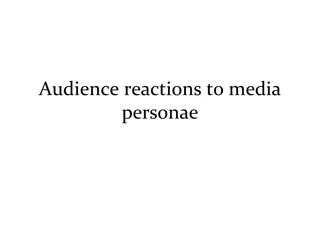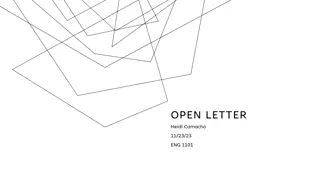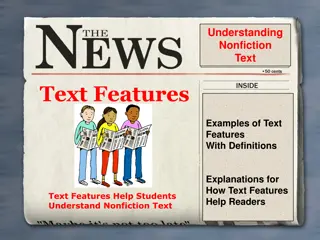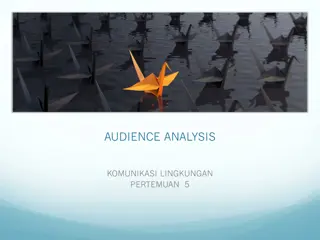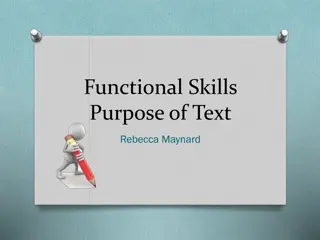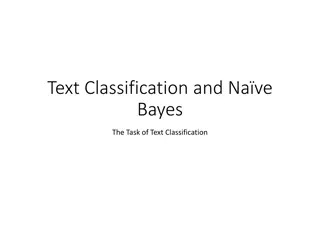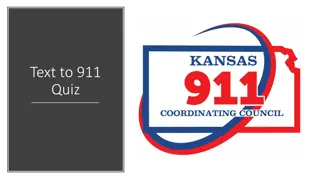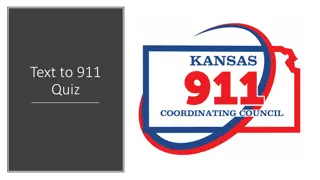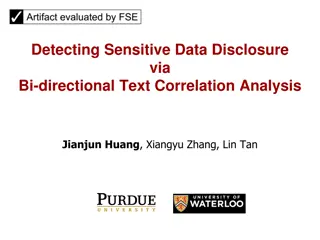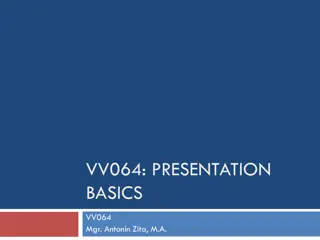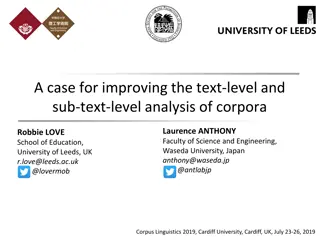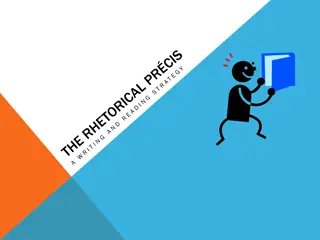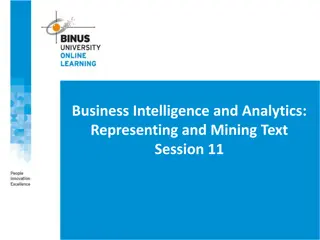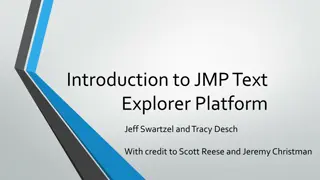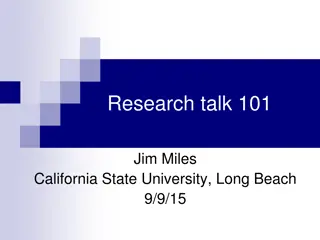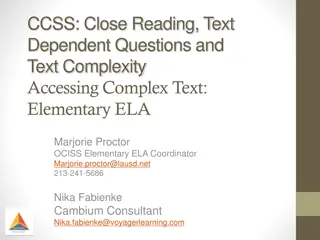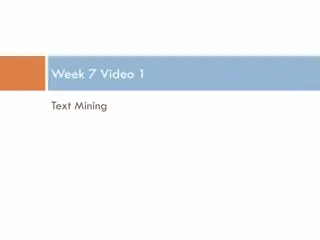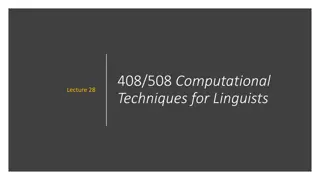Understanding Audience and Purpose in Text Analysis
When analyzing written texts, identifying the purpose and audience is crucial. The purpose reflects the reason behind the text, while the audience indicates who the text is intended for. By recognizing these aspects, one can better understand the content, language, and overall impact of the text. Various types of purposes, such as presenting a point of view, promoting a product, or entertaining, can guide the analysis process. Examining clues from the text's context, layout, and language helps in discerning its purpose and target audience effectively.
Download Presentation

Please find below an Image/Link to download the presentation.
The content on the website is provided AS IS for your information and personal use only. It may not be sold, licensed, or shared on other websites without obtaining consent from the author. Download presentation by click this link. If you encounter any issues during the download, it is possible that the publisher has removed the file from their server.
E N D
Presentation Transcript
NATIONAL 5 ENGLISH UNDERSTANDING FOR ANALYSIS AND EVALUATION Question types and examples
A&E OUTCOME 1: READING To understand, analyse and evaluate detailed written texts by: 1.1 Identifying and explaining the purpose and audience, as appropriate to genre 1.2 Identifying and explaining the main ideas and supporting details 1.3 Applying knowledge and understanding of language to explain meaning and effect, using appropriate critical terminology
A&E OUTCOME 1: READING Identify the purpose Identify means pick out This means you have to decide/ pick out the main reason why this article was written Identify the genre genre means type of text Common genres are fiction, non-fiction, drama, poetry, newspaper article get the idea? Know what these are AND what they look like. Identify the audience To answer this you need to try to work out who this piece of writing was aimed at/ who you think would enjoy reading it. You might also want to/ need to give a reason for your answer.
Audience and Purpose When you are approaching a text for the first time, whether as a reader or as a writer, the two most important questions you need to ask yourself are: What is it for? (Purpose) and Who is it aimed at? (Audience) The text s purpose and audience should be reflected in almost every aspect of its appearance and language from its layout and use of pictures to the complexity of its sentences and the formality of its style.
Audience and Purpose In order to help you decide on a text s audience and purpose you should look for any available clues as to the type of text you have been given and its context. In your exam paper you will probably be told when and where the text you have been given to study first appeared. Use this information together with any recognizable conventions of presentation, layout and language to help you decide on the text s purpose and audience.
Identifying Purpose The purpose of ay text will always fall under one of the 3 umbrella headings:
Identifying Purpose Some common and more specific purposes are listed below: To present a point of view To present a balanced view of two sides of an argument To analyse / comment on a topic To promote a product or service To explain something To complain / disagree with something To express feelings To record / share experiences To entertain To give information
TASK Complete the For practice task on p3 of Reading for Understanding, Analysis and Evaluation Read and make a note of what is meant by the terms Register and Tone
Identifying Audience Closely tied in with the writer s aims is the readership or audience that they have in mind. Most of the pieces you will be given to analyse will have been written for the non-specialist, general adult reader. But writing might also be directed at: Small children Teenagers Members of a profession or people with expert knowledge People with a specialist interest in a topic.
TASK Complete the For practice task on pages 4&5 of the textbook.
Question Types Understanding What is the writer saying? Analysis How is the writer saying it? Evaluation How effectively is he/she saying it?
Question Types Understanding 1.2 Identifying and explaining the main ideas and supporting details Own words question. The linking question. Summarising Quote a word/expression
Question Types Understanding Own words question: The most common task is to be asked to pick out a fact and explain it in your own words. A question might ask you to select a number of points the writer makes and repeat them in your own words. Such a question frequently includes the word summarise Summarise the main points the writer makes about
Own Words Practice Example 1 People think that the written language seen on mobile phone screens is new and alien, but all the popular beliefs about texting are wrong. Its distinctiveness is not a new phenomenon, nor is its use restricted to the young. There is increasing evidence that it helps rather than hinders literacy. Texting has added a new dimension to language use, but its long- term impact is negligible. It is not a disaster. Question The writer tells us that all the popular beliefs about texting are wrong . Look at the remainder of the paragraph, and then explain in your own words what two of these popular beliefs are.
Own Words Practise Gloss of phones help rather than hinders literacy I.E the use of mobile phones may actually improve people s knowledge of language rather than affect it negatively. Gloss of Its distinctiveness is not a new phenomenon, nor is its use restricted to the young. I.E the use of mobile phones is not a new craze that is only confined to young people. (or similar)
Own Words Practice Example 2 The BBC is a massive sponsor, uniquely independent through its licence fee and the guardian of public service broadcasting. But, as the fight for the control of communications hots up, friends of the BBC both inside and out are alarmed that all this is in jeopardy: the BBC has become too much of a self-seeking institution, too preoccupied with its ratings at the expense of good broadcasting, and unwisely over-extended financially. Question What are the three reasons for causing alarm to friends of the BBC? Use your own words as far as possible.
Own Words Practice Gloss of: the BBC has become too much of a self-seeking institution too preoccupied with its ratings at the expense of good broadcasting and and unwisely over-extended financially. I.E: - The BBC is too concerned with its own personal interests - Is jeopardising the quality of broadcasting in order to increase ratings - Is at risk of serious overspending Or similar
Own Words Further Practice 1. Stories about haunted places are always fascinating. What goes on there, and how, and why? Some hauntings can be explained as the results of ordinary trickery. In others some natural cause is at work, though it has not yet been traced. Question: What 2 explanations does the writer suggest to account for the belief that some place are haunted? 2. I m nocturnal. I love the moonlight, the shadows, the dark places, the dappled murk. I m not poetic. I m simply being true to my nature, my nocturnal nature. Like all tarantulas. Question: In your own words, in what way is the speaker like all tarantulas?
Question Types Linking Questions Formula: 1.Quote which part of the sentence links back 2.Explain what previous ideas it links back to 3.Quote which part of the sentence that links forward 4.Explain what subsequent ideas it links forward to
Linking Questions Practice Example The 7.15 dance class is full, as was the six o clock, as is the 8.30. In the reception area of Edinburgh Dancebase, learners, ranging from the middle-aged, fresh from work, to students, mill around waiting to dance. Unlikely as it may at first seem, this is occurring across the country. Against similar winter backdrops people are queuing up to learn to dance. National inhibition is being shed as salsa, meringue, and cumbia beats force hips to sway rhythmically and partners to twist complicatedly. French ceroc classes are filling up, street dancing to hip hop is being used as an exercise class. Even ballroom dancing is enjoying something of a renaissance. Question By referring to specific words or phrases, show how the first sentence in the second paragraph performs a linking function in the line of thought. 2
Linking Questions Practice Answer: The word this links back to what was discussed in the previous paragraph which was the idea of the dance classes in Edinburgh being full The words is occurring across the country link to what is coming up in the next paragraph, which is the idea of different styles of dance becoming more popular throughout the nation
Linking Questions Practice Example 6 William Shakespeare is easily the best-known of our English writers. Virtually every man in the street can name some of his plays and his characters, and many people can also recite lines of his poetry by heart. However, despite our familiarity with his work, we know relatively little of the man himself. We do not know when or why he became an actor, we know nothing of his life in London, and almost nothing of his personal concerns. Question By referring to specific words or phrases, show how the third sentence acts as a link in the argument. 2
Linking Questions Practice Example 7 Mary Stuart was certainly rated a beauty by the standards of her own time: even John Knox described her as pleasing . In her height, her small neat head, and her grace she resembled the contemporary ideal. It was the type of beauty which her contemporaries were already learning to admire in art, and could now appreciate in life, all the more satisfyingly because it was in the person of a princess. Not only the appearance, but also the character of Mary Stuart made her admirably suited to be a princess of France in the age in which she lived. Mary was exactly the sort of beautiful woman, not precisely brilliant, but well-educated and charming, who inspired and stimulated poets by her presence to feats of homage. Question Show how the first sentence of the second paragraph acts as a link in the argument. 2
Linking Questions Practice Example 8 The problem here is political rather than financial capacity. The pinch will come in other resource areas, such as health spending. People over 65 consume three times as many prescription items as other age groups. Nearly half of those with some measure of disability are over 70. But the resource question, meeting the material needs of the old and elderly, is only half the story. The real problem lies elsewhere in the imagination. What are the old for? Who are they, and do traditional divisions of human life into childhood, youth, middle- age and old-age still fit our experience? Question What is the function of the first sentence in the second paragraph in this passage? By referring closely to specific words and phrases, show how it fulfils this function.
Summarising You will often be asked to summarise a writer s main points in order to show the following: that you have grasped the overall meaning of the text and followed the writer s line of thought. That you are able to pick out key information and put it into your own voice ( a degree of paraphrasing is acceptable) It is recommended that you use bullet points to summarise main points unless you are asked specifically to write in prose.
Summarising Therein lie the polar points of Scottish tourism. On the one hand, there is the attitude of those who couldn t care less, who regard service as a synonym for servility, who treat customers as if they are something smelly stuck to their shoe. Meanwhile, there are those who take satisfaction from other people s pleasure, who embrace the Welcome to Scotland slogan, who are enthusiastic ambassadors for their country and will attempt to kill you with kindness Question: In your own words, summarise he two opposite attitudes that are shown towards tourists visiting Scotland (4) Answer: Some people are disinterested and think that good service is a form of brownnosing Other people take pride and pleasure in making the Scottish tourists experience a positive one.
Summarising Another health risk comes from the salt, sodium nitrate and potassium nitrate which are added to bacon. These last two chemicals stop bacteria and keep the meat bright red so it looks fresh. However, nitrites and nitrates have also been show to increase the risk of cancer in animals. Amid such health fears, the British pig industry says it cut down the level of potentially harmful additives. But there is a limit to how much can be reduced. If you go too far it stops becoming a cured meat said a spokesman for the British Pig Association. Instead it s fresh meat and it doesn t keep so long. Question: Using your own words as far as possible summarise the key points that have been made in this extract. (4)
Summarising The equation of risk for the Arctic convoys was grim. During the winter the ice, extending southward, obliged them to pass within two or three hundred miles of German-held territory. The summer route was further north and therefore further away from the German airfields, but the daylight was perpetual. The winter convoys had to pass dangerously close to German bases. The summer ones were exposed twenty-four hours a day to German air attack for at least one third of the voyage Question: Using your own words as far as possible summarise the various risks the Arctic convoys faced.
Summarising The cold was now intense. To keep a watch, especially a watch on the bridge, was torture: the first shock of bitter wind that seared the lungs, left a man fighting for breath: if he had forgotten to don gloves first the silk gloves, then the woollen mittens, then the sheepskin gauntlets and touched a handrail, the palms of his hands seared off, the skin burnt as by white-hot metal. On the bridge, the deadly chill crept upwards from feet to calves to thighs, nose and chin turned white with frostbite and demanded immediate attention, and then, by far the worst of all, the end of the watch, the return below deck, the excruciating agony of returning circulation. Question: Using your own words as far as possible to summarise the various problems faced by many men aboard the Arctic convoy.
Summarising Opposite to me the fire burned bright and clear, and on the hearth- rug, seemingly asleep, lay the dog. In about twenty minutes I felt exceedingly cold air pass by my cheek, like a sudden draught. I thought the door to my right onto the landing must ve got open; but no, it was closed. I then turned my glance to my left and saw the flame of the candles violently swayed as if by the wind. At the same moment the watch slid from the table softly, softly no visible hand it was gone. I sprang up and looked around the floor no sign of the watch. Three slow, loud, distinct knocks were now heard at the bed-head; my servant called out, is that you, sir? Question: Using your own words as far as possible to summarise the different things that alarmed and frightened the writer
Question Types Analysis 1.3 Applying knowledge and understanding of language to explain meaning and effect, using appropriate critical terminology Word Choice Imagery Sentence Structure Punctuation
Sentence structure Long and complex/short simple sentences Complex sentences may mimic complex ideas; short sentences have impact Repeated ideas will be emphasised or spotlighted Repetition of words or phrases List Provides detail, complexity, etc. Climax / anticlimax following a list Creates suspense/shows easing of tension Parenthesis Adds extra information, comment or clarification
Sentence structure Questions / exclamations / commands Achieve a particular tone, e.g. emotive (arousing strong feelings) Sentences without verbs (minor sentences) Create a colloquial (informal) style or build tension Unusual word order, e.g. inversion Alters emphasis; may build tension Sentences with symmetrical pattern of structure but with contrasting (opposite) ideas Provide contrast
Sentence structure Commas Separate items in a list or clauses in a sentence Pairs of brackets, dashes or commas Create parenthesis (see above) Colon (or dash) Introduces a list, example, explanation or quotation Semi-colon Separate complex items in a list (usually a very long list); separate two distinct, but connected, sentences Inverted commas Indicate quotation or speech; sometimes used to indicate irony
Sentence structure Example 1 From whence comes this compulsion to climb mountains? Why do I have this compulsion to get to the top of every insignificant bump on the landscape? Why, no matter how breathless, bruised, battered and bedraggled I become while hillwalking, do I return with a grin on my face and a desire to go out and do it again? Question Here the author reflects on his need to climb mountains. Comment on how two aspects of sentence structure are used to explore his feelings. 4
Sentence structure Example 1: Answer The writer s use of questions shows that he is conflicted in himself and is questioning his innate desire for mountain climbing (2) The use of a list breathless bruised battered and bedraggled emphasises the extent of hardships that he endures as a result of hill climbing, yet surprising to him and the reader, he chooses to continue to climb mountains. (2) (The alliteration of the letter b is certainly significant but as this is a sentence structure question we will overlook it in this instance.)
Sentence structure Example 2 But as that new way of living arrives as we retreat from the wild places, and the fences of national parks go up; as we cease the exploitation of animals, and the cow, the camel, the sheep, the chicken and the pig become items in modern exhibition farms, where schoolchildren see how mankind used to live; as our direct contact with our fellow creatures is restricted to zoos, pets and fish tanks; and as every area of natural beauty is set about with preservation orders and rules to keep human interference to a minimum will we not be separating ourselves from our planet in order, as we suppose, to look after it better? Question Identify an aspect of sentence structure being used here and explain how it supports or clarifies the author s argument. 2
Sentence structure Example 2: Answer The writer has used a variety of colons and semi colons to create a list of all the ways that humans are (ironically) separating themselves from the natural beauty of the planet in order to preserve it and look after it. The use of the list is extremely effective as it gives the impression that the reader is not convinced that the measures we are going to are effective or correct but instead feels that we have gone too far. (2)
Sentence structure Example 3: We stepped out of the bar, but the noise continued because we were now standing under the railway on stilts that circles Chicago which is itself quite coaster-like. Richard said something about romantic adventure in the modern world , and told me he had a thing coming up in Holiday Park, an amusement park near Frankfurt, Germany: he intended to spend the entire summer, day after day, week after week, on one of the new breed of metal megacoasters that have done so much to revive the fortunes of amusement parks. Explain the reason for: (a) the inverted commas round the words romantic adventure in the modern world (2) (b) the colon after the words an amusement park near Frankfurt, Germany . (2)
Sentence structure Example 3 answer: We stepped out of the bar, but the noise continued because we were now standing under the railway on stilts that circles Chicago which is itself quite coaster-like. Richard said something about romantic adventure in the modern world , and told me he had a thing coming up in Holiday Park, an amusement park near Frankfurt, Germany: he intended to spend the entire summer, day after day, week after week, on one of the new breed of metal megacoasters that have done so much to revive the fortunes of amusement parks. Answer: (a) the writer has used inverted commas to show that she is quoting Richard word for word and that the reader doesn t fully appreciate or understand what Richard meant by this. (b) The use of colon is to introduce the explanation of what the romantic adventure and thing coming up was: it meant the entire summer in a German amusement park.
sentence structure further practice 1. I was beginning to regret having lied because of love, I suppose. In what way does the sentence structure reveal the feelings of the writer? (be specific look at the punctuation which has been used) 2. He s got this very loud laugh laughing at nothing, if you know what I mean and he stands there, slurring his words because he s had too much to drink. How does the sentence structure used here reveal the feelings of the writer? 3. In the 1930s only the superior classes could travel in style. What does the use of inverted commas suggest about the writer s attitude towards the 1930 s class system? 4. He lurked close by. Shadows. Footsteps echoed. I clenched my teeth. Held my breath. Comment on the effectiveness of the sentence structure used above. What does it reveal about the writer s feelings at this point?
Expression and Word Choice Word Choice is exactly as it says a CHOICE. The writer has CHOSEN to use a particular word over another in order to achieve a desired effect on the reader. The boy sauntered/ strut/ swaggered/ moped/ marched into the room. What do each of these different words reveal about the boy? The meaning of the sentence changes entirely when a different word is used.
Expression and Word Choice How to answer a word choice question: Step 1: State the denotation of the word (this is it s definition) Step 2: explain the connotations of the word (These are the associations we give to words, the ideas we are made to think of when we hear or read any given word. ) Step 3: Link it back to the question being asked
Example Word Choice Questions new mother (pigs) are routinely confined in farrowing crates. The crates are designed to stop sows crushing their young Explain how the writer s word choice helps you to better understand his opinion of the treatment of cows in the UK. 1. The word crushing comes from the word crush which means to squash/mash 2. This suggests that the pigs are being packed so tightly that they are at risk of being crushed to death if they are not confined to these crates. This is quite a disturbing way to die. 3. This helps us to understand the negativity felt by the writer who evidently believes that such conditions are appalling and inhumane.
Example Word Choice Questions 1. new mother (pigs) are routinely confined in farrowing crates. The crates are designed to stop sows crushing their young Explain how the writer s word choice helps you to better understand his opinion of the treatment of cows in the UK. 2. My guest was lying sprawled on his back. There was a long knife through his heart which skewered him to the floor. Explain how the writer s word choice adds to the horror of the scene
Example Word Choice Questions 3. Tom cringed as Mr Connor leaned towards him. Explain what the writer s word choice cringed tells us about the relationship between the characters in this extract. 4. The figure was shrouded in a garment of deepest black which concealed its head, its face, its form and left nothing of it visible except outstretched hands (a) What associations does the choice of shrouded add to this scene? (b) Compare the alternatives covered or cloaked instead.
Example Word Choice Questions 5. A street urchin gnawed on the remains of a hamburger he had retrieved from a bin Explain how the writer s word choice gnawed helps you to understand how the boy ate. 6. A lonely boy was reading near a feeble fire Comment on the effectiveness of the word choice feeble and explain how it adds to the scene.
Example Word Choice Questions 5. A street urchin gnawed on the remains of a hamburger he had retrieved from a bin Explain how the writer s word choice gnawed helps you to understand how the boy ate. 6. A lonely boy was reading near a feeble fire Comment on the effectiveness of the word choice feeble and explain how it adds to the scene.


